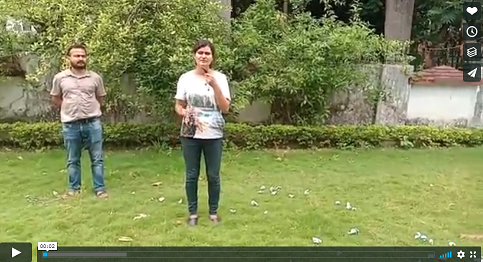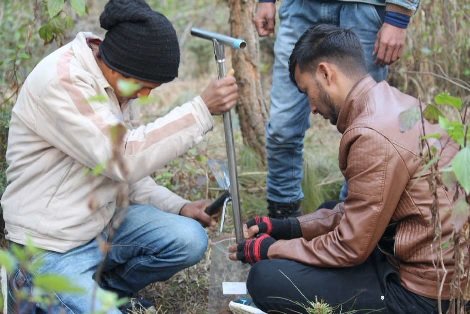|
Cycle 8 (2019 Deadline)
Planning plantations: past learning, toward triple wins in carbon, biodiversity and livelihoods
PI: Rajesh Thadani (thadani_rajesh@hotmail.com), Centre for Ecology Development and Research (CEDAR), in partnership with Kumaun University
U.S. Partner: Forrest Fleischman, University of Minnesota
Project dates: November 2019 - August 2022
Project Overview
 | | Dr. Thadani and the team provide training on Mycorrihzae Sporocarp. |
Governments worldwide are increasingly aiming to increase tree cover, yet the impacts of afforestation programs are poorly understood. Recent evaluations find that they often have unintended negative impacts or tradeoffs between the triple goals of carbon storage, biodiversity protection, and livelihoods. This proposal complements an existing NASA-funded project evaluating the impact of plantations on land cover and livelihoods of poor forest dependent people in the Indian state of Himachal Pradesh. PEER funding will allow CEDAR, an Indian research NGO, to measure carbon storage and biodiversity in the same plantation areas and disseminate results through planned events, working in partnership with a local university. This project will make it possible to evaluate when–and how–afforestation projects achieve the triple win of storing more carbon, protecting biodiversity, and enhancing rural livelihoods, more fully accounting for the potential benefits and costs of plantations in the Himalayas. This project will provide important data on carbon and biodiversity in plantations of multiple age cohorts in diverse ecological types, and develop methodological innovations for analysis of carbon storage, biodiversity, and its relationship to land cover and livelihoods. India provides an ideal environment for exploring the impacts of afforestation programs due to its history of nearly 50 years of plantation programs, the presence of important biodiversity and carbon stocks, and the large number of people at the base of the economic pyramid in India who meet their daily livelihood needs from forests. There is a growing demand in India for accurate estimations of carbon stocks and biodiversity impacts resulting from tree plantations in order to evaluate the effectiveness of afforestation. This proposal will address this demand while also filling a long-standing gap in scientific information about the Himalayas, where social and ecological data are seldom collected together. With the results of the proposal, the researchers involved will contribute to understanding which kinds of afforestation programs have been most effective at achieving triple wins, contribute to policy development in Indian forestry through planned events, and enhance potential for triple wins by developing innovative methods that can be adapted by other countries.
 |  | | The project team collects soil samples and conducts soil sample analysis (photos courtesy of Dr. Thadani). |
This project is also expected to contribute to USAID’s Partnership for Sustainable Forests in India (Forest PLUS) program and to provide technologies and practices that can be transferred to other developing country contexts. This will be done in three ways. First, they will develop innovative methods to identify conditions when synergies among triple goals of carbon storage, biodiversity, and livelihoods are realized. Their findings will provide inputs to India’s forest policy and management, enabling governments and external funders to evaluate tradeoffs between afforestation goals, especially those impacting forest dependent people at the bottom of the pyramid (BOP), in designing future afforestation programs. Second, they will engage with three communities—forest-dependent people at the BOP, forest departments, and NGOs—to enhance impacts of this project by providing training and workshops. BOP populations will also be engaged during data collection and dissemination, and in this way, and by involving elected local governments, the PEER team will increase the representation of vulnerable groups in forest decision making. Third, the researchers will assist in the development of curriculum related to assessment of triple wins in afforestation. They will partner in developing field-based courses with partners at educational institutes, including Kumaun University, the University of Minnesota, India’s Forest Research Institute, the G.B. Pant Institute, and the International Centre for Integrated Mountain Development. The proposal will directly educate two women researchers at CEDAR and a team of local youth in field methods and forest policy.
Final Summary of Project Activities
Under this project, the PI Dr. Rajesh Thadani, co-PI Dr. Vishal Singh, and their team at CEDAR measured forest carbon stored in above ground biomass (AGB) after measuring tree diameters in 42 large plots (1500 m2) and 60 smaller plots using already existing allometric equations. Smaller plots were set up to assess mycorrhizal diversity, as evidenced by mushroom sporocarps monitored during the monsoon season. These studies were carried out in plantation areas in Kangra District of Himachal Pradesh (HP). Soil carbon measurements were made for each of these plantations at the CEDAR soil laboratory. The project aimed to evaluate when and how afforestation projects achieve the triple win of storing more carbon, protecting biodiversity, and enhancing rural livelihoods, more fully accounting for the potential benefits and costs of plantations in the Himalayas. Although it was envisaged as a one-year project, COVID-19 related interruptions in field work led to the project going into several no-cost extension periods to complete the field studies.
The team found AGB values ranging from 100 – 350 metric tons per hectare on average for the different kinds of plantations in Kangra. These values fit into what Singh and Singh (1992) report for good secondary forests of the same species in the central Himalaya. This would indicate that in terms of biomass, and carbon sequestered, the HP plantations had achieved their required goals of replicating natural forests. However, many plantations, as evidenced by multiple girth class distributions, indicated repeated planting on the same sites. The lack of baseline data of the original forest condition was a shortcoming, as this precluded an understanding of biomass at the start of the plantation period. A high biodiversity as represented by mycorrhizal and saprophytic mushroom fruiting bodies was found in these plantations, indicating that these plantations had the fungal diversity of natural forests. While plantations help provide focus and give a reason for forest protection, forests regenerate well naturally. Old plantations, established in the 1980’s and 1990’s, were in some cases indistinguishable from natural forests. If protection from human destruction had been good, not just the planted seedling and saplings, but all forms of natural regeneration had helped bring degraded areas back under good forest cover. The majority of plantations also showed good mycorrhizal diversity with a wealth of mushroom fruiting bodies that resemble a natural forest. But this is not to say plantations were wholly successful. Many of those where the community felt excluded had failed for reasons ranging from fires that destroyed regeneration to intrusion by grazing animals. The value of old plantations, especially of chir pine (Pinus roxburghii) that dominated aforestation efforts in the 1980’s and 1990’s, was also questionable. The species is of low importance to local communities, and the ban on green felling locks up timber value, thus preventing benefits from coming to local communities.
Dr. Thadani reports that the findings and learnings from his team’s studies, hampered as they were by field work restrictions, led to two excellent consultative workshops in Himachal in April and August 2022. Inputs from forest department officials and open deliberations with community representatives and forest ecology experts helped these disparate groups get a shared perspective and bring out some strong policy recommendations. As a side benefit of the project that was not initially planned, the researchers have also published an identification manual on mushroom fruiting bodies, which aims to help bring to life the diversity of beneficial fungi in different forest types and increase understanding of forest functioning and diversity among a general audience.
The PEER project has allowed CEDAR to refocus its attention on Himalayan forests. The researchers were also able to expand the geographical area of their work from the Himalayan state of Uttarakhand to Himachal Pradesh. Through this collaboration, they have also started working with KISAN, a research network in Himachal, in addition to the collaboration with U. S. partner Dr. Forrest Fleischman at the University of Minnesota. The project also served as a foundation for the development of another new research partnership with Dr. Harry Fischer of the Swedish University of Agricultural Sciences and Dr. Alark Saxena of Northern Arizona University on two separate grants funded by Swedish Research Council (FORMAS). Although this PEER project has now ended, Dr. Thadani and his colleagues expect to continue their collaboration with Dr. Fleischman and their other counterparts on expanding our understanding of forest plantations and their impacts. They also plan to build on their PEER research to focus on the issue of forest fires, which have been increasing in numbers in the region. Besides the FORMAS grants, the team have also secured funding from the Deutsche Gesellschaft für Internationale Zusammenarbeit (GIZ) and they are applying for additional support from Indian and international funders.
Publication
Anvita Pandey, Rajesh Thadani, N.S.K. Harsh, and Vishal Singh. 2022. Mushrooms in forest plantations of Kangra Valley. Centre for Ecology Development and Research.
Available for free download at https://www.cedarhimalaya.org/images/pdf/masrooms.pdf
Back to PEER Cycle 8 Grant Recipients
|
|
|
|






